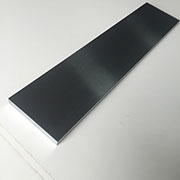|
Niobium
|
|
|
|
|
|
Discovery date
|
1801
|
|
Discovered by
|
Charles Hatchett
|
|
Origin of the name
|
The name comes from Niobe from Greek mythology, who was the daughter of king
Tantalus. This was chosen because of niobium's chemical similarity to tantalum
|
|
Atomic number
|
41
|
|
State at 20°C
|
Solid
|
|
Electron configuration
|
[Kr] 4d45s1
|
|
Melting point
|
2477°C, 4491°F, 2750 K
|
|
Boiling point
|
4741°C, 8566°F, 5014 K
|
|
Density (g cm−3)
|
8.57
|
|
Relative atomic mass
|
92.906
|
|
Key isotopes
|
93Nb
|
|
CAS number
|
7440-03-1
|
|
|
|
|
|
|
|
Properties
|
|

|
Niobium is a rare, soft, malleable, ductile, gray-white metal. It has a body-centered cubic crystalline structure and in its physical and chemical properties it resembles tantalum. It must be placed in a protective atmosphere when processed at even moderate temperatures because it tends to react with oxygen, carbon, the halogens, nitrogen, and sulfur. The metal is inert to acids, even to aqua regia at room temperatures, but is attacked by hot, concentrated acids, and expecially by alkalis and oxidizing agents.
|
|
|
|
|
Application
|
|
Used for the production of high-temperature-resistant alloys and special stainless steels
Used in cutting tools
Used in stainless steel alloys for nuclear reactors, jets, missiles, cutting tools, pipelines, super magnets and welding rods.
|
Chengyi provides tantalum:
● rod
● bar
● plate
● strip
● wire
● target
● pipe
We also provide other customized items.

Feel free to send us a message, give us a call 86-0917-3870-390 or mail us: info@chengyimetal.com
|
|